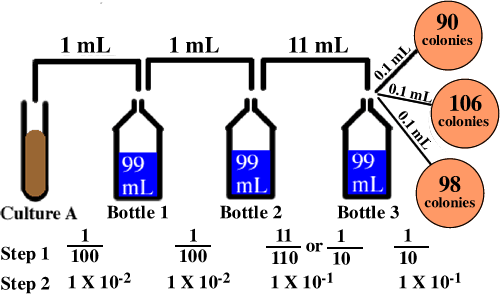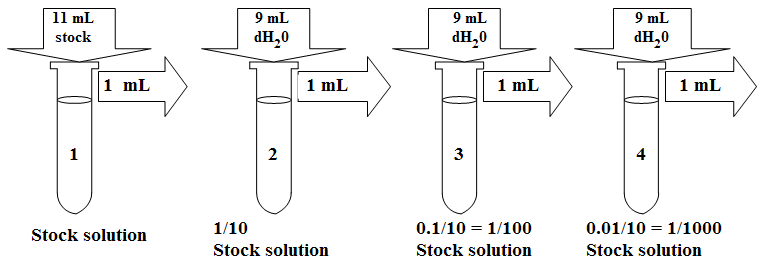BIOL 1406
Serial Vs Parallel Dilution SECOND: Also use a serial dilution when the dilution factor is so large that the amount of stock solution needed to make the dilution in one step (using the formula C 1V 1 = C 2V 2) is too small to measure accurately. Remember that the smallest volume you can measure with the micropipettors is 2 μL.
PreLab 2.5
When do I use the serial dilution technique instead of the parallel dilution technique?
Another way to make dilutions is to use some of your existing stock solution to make a dilute solution, then use some of the dilute solution to make an even more dilute solution, then use some of that solution to make an even more dilute solution, and so on. This procedure is called the serial dilution technique.
A serial dilution is the dilution of a sample, in 10-fold dilutions. As shown in the illustration below, it begins when 1 mL of the bacterial sample is added to 9 mL, and it is mixed together (creating a 10-1 dilution). Then, 1 mL from that mixture is added to 9 mL, and it is mixed together (a 10-2 dilution). Parallelism is defined as an established parallel relationship between a dose-response curve from a study sample dilution series and a curve from a calibration standard series, with no difference among back-calculated concentrations for multiple dilutions of a study sample. As of the issuance of this guideline, domestic and international. Parallel dilution is the dilution of a solution with equal quantity of the same solvent with which the solution is made. E.g., 1mL of 100µg/ml strength aqueous solution can be diluted to 2mL of. Serial and Parallel Dilution A serial dilution is a stepwise preparation in which each dilution serves as the source for the next dilution.
There are two situations where serial dilutions should be used rather than parallel dilutions:
Parallel Dilution Calculator
FIRST: Use a serial dilution when you need several solutions of the same solute and there is a constant dilution factor. For example, suppose you have a 2 M stock solution of KMnO4 and you want to make 15 mL of each of the following concentrations of KMnO4: 0.2 M, 20 mM, 2 mM, and 0.2 mM. Notice that the concentration of each solution is 1/10th the concentration of the previous solution in the series. The factor by which each solution is diluted compared to the previous one is called the dilution factor.
To calculate the dilution factor for each dilution, divide the concentration of the starting solution by the concentration of the diluted solution. For example, for the first dilution 2 M divided by 0.2 M equals 10. For the second dilution, 0.2 M divided by 20 mM equals 10. For the third dilution, 20 mM divided by
2 mM equals 10. And for the fourth dilution 2 mM divided by 0.2 mM equals 10. Therefore, this series has a constant dilution factor of 10.
Serial Vs Parallel Dilution Method Pdf
:Also use a serial dilution when the dilution factor is so large that the amount of stock solution needed to make the dilution in one step (using the formula C.jpg) 1V1
1V1 = C2V2) is too small to measure accurately. Remember that the smallest volume you can measure with the micropipettors is 2 μL.
= C2V2) is too small to measure accurately. Remember that the smallest volume you can measure with the micropipettors is 2 μL.| YOUR TURN | ||
| You have a stock solution of 1.6 M sucrose and you need to prepare solutions with the following concentrations of sucrose: 0.4 M, 0.1 M, 25mM, and 6.25 mM.What is the dilution factor for this series? | Hint | Check your answer. |
You plan to prepare 4 solutions by serial dilution. The concentration of your stock solution is 2.7 M and the dilution factor is 3. What will be the molarity of your four solutions? | Hint | Check your answer. |
| You have a 1.0 M stock solution of glycine (an amino acid), and you need 5 mL of a 0.1 mM solution. By what factor do you need to dilute your stock solution? | Hint | Check your answer. |
| Using the formula C1V1 = C2V2, calculate the amount of stock solution you need to make 5 mL of a 0.1 mM solution from a 1.0 M stock solution. Express your answer in mL: | Hint | Check your answer. |
| Do you have a measuring device that will accurately measure this amount? YES NO | Hint | Check your answer. |
| Explain. | Hint | Check your answer. |
| YOUR TURN | ||
For each of the following situations, state whether the parallel or serial dilution technique would be more appropriate, and explain your reasoning. | ||
You need 20 mL of a 5 mM glycerol solution. You have a 1.0 M glycerol stock solution on hand. Which dilution technique is appropriate and why? | Hint | Check your answer. |
You have a 2.5 M stock solution of EDTA. You need 50 mL each of 2 M, 0.5 M, 0.2 M and 0.1 M solutions of EDTA. Which dilution technique is appropriate and why? | Hint | Check your answer. |
You have a 2.0 M stock solution of sucrose. You need 100 mL each of 1 M, 0.5 M, 0.25 M, 0.125 M, and 62.5 mM sucrose solutions. Which dilution technique is appropriate and why? | Hint | Check your answer. |
Close this browser window to return to Blackboard and complete the practice quiz and assessment quiz.
This section is not a recipe for your experiment. It explains someprinciples for designing dilutions that give optimal results. Onceyou understand these principles, you will be better able to designthe dilutions you need for each specific case.

Often in experimental work, you need to cover a range ofconcentrations, so you need to make a bunch of differentdilutions. For example, you need to do such dilutions of thestandard IgG to make the standard curve in ELISA, and then againfor the unknown samples in ELISA.
You might think it would be good to dilute 1/2, 1/3, 1/10, 1/100.These seem like nice numbers. There are two problems with this series ofdilutions.
Serial Vs Parallel Dilution

- The dilutions are unnecessarily complicated to make. You need to do a differentcalculation, and measure different volumes, for each one. It takes a longtime, and it is too easy to make a mistake.
- The dilutions cover the range from 1/2 to 1/100 unevenly.In fact, the 1/2 vs. 1/3 dilutions differ by only 1.5-fold in concentration,while the 1/10 vs. 1/100 dilutions differ by ten-fold. If you are going tomeasure results for four dilutions, it is a waste of time and materialsto make two of them almost the same. And what if the half-maximal signaloccurs between 1/10 and 1/100? You won't be able to tell exactly where itis because of the big space between those two.
Serial dilutions are much easier to make and they cover the range evenly.
Serial dilutions are made by making the same dilution step over and over,using the previous dilution as the input to the next dilution in each step.Since the dilution-fold is the same in each step, the dilutionsare a geometric series (constant ratio between any adjacent dilutions).For example:
- 1/3, 1/9, 1/27, 1/81
- 1/5, 1/25, 1/125, 1/625
When you need to cover several factors of ten (several 'orders of magnitude') witha series of dilutions, it usually makes the most sense to plot the dilutions(relative concentrations) on a logarithmic scale. This avoids bunching mostof the points up at one end and having just the last point way fardown the scale.
Before making serial dilutions, you need to make rough estimatesof the concentrationsin your unknowns, and your uncertainty in those estimates. For example,if A280 says you have 7.0 mg total protein/ml, and you thinkthe protein could be anywhere between 10% and 100% pure, then yourassay needs to be able to see anything between 0.7 and 7 mg/ml.That means you need to cover a ten-fold range of dilutions, or maybe a bitmore to be sure.
If the half-max of your assay occurs atabout 0.5mg/ml,then your minimum dilution fold is(700mg/ml)/(0.5mg/ml) = 1,400.Your maximum is(7000mg/ml)/(0.5mg/ml) = 14,000.So to be safe, you might want to cover 1,000 through 20,000.
In general, before designing a dilution series, you need to decide:
- What are the lowest and highest concentrations (or dilutions)you need to test in order to be certain of finding the half-max? Thesedetermine the range of the dilution series.
- How many tests do you want to make? This determines the size of theexperiment, and how much of your reagents you consume. More tests will coverthe range in more detail, but may take too long to perform (or cost too much).Fewer tests are easier to do, but may not cover the range in enough detailto get an accurate result.
- What volume of each dilution do you need to make in order to haveenough for the replicate tests you plan to do?

Now suppose you decide that six tests will be adequate (perhapseach in quadruplicate).Well, starting at 1/1,000, you need five equal dilution steps (giving yousix total dilutions counting the starting 1/1,000) that end ina 20-fold higher dilution (giving 1/20,000). You can decide on a goodstep size easily by trial and error. Would 2-fold work? 1/2, 1/4, 1/8, 1/16, 1/32. Yes, in factthat covers 32-fold, more than the 20-fold range we need. (The exact answeris the 5th root of 20, which your calculator will tell you is 1.82 foldper step. It is much easier to go with 2-fold dilutions and gives about thesame result.)
So, you need to make a 1/1,000 dilution to start with. Then you need toserially dilute that 2-fold per step in five steps. You could make 1/1,000 byadding 1 microliter of sample to 0.999 ml diluent. Why is that a poor choice?Because you can't measure 1 microliter (or even 10 microliters) accuratelywith ordinary pipeters. So, make three serial 1/10 dilutions(0.1 ml [100 microliters] into 0.9 ml): 1/10 x 1/10 x 1/10 = 1/1,000.
Now you could add 1.0 ml of the starting 1/1,000 dilution to1.0 ml of diluent, making a 2-fold dilution (giving 1/2,000).Then remove 1.0 ml from that dilution (leaving 1.0 ml for yourtests), and add it to 1.0 ml of diluent in the next tube (giving1/4,000). And so forth for 3 more serial dilution steps (giving1/8,000, 1/16,000, and 1/32,000). You end up with 1.0 ml of each dilution.If that is enough to perform all of your tests, this dilution planwill work. If you need larger volumes, increase the volumes you useto make your dilutions (e.g. 2.0 ml + 2.0 ml in each step).